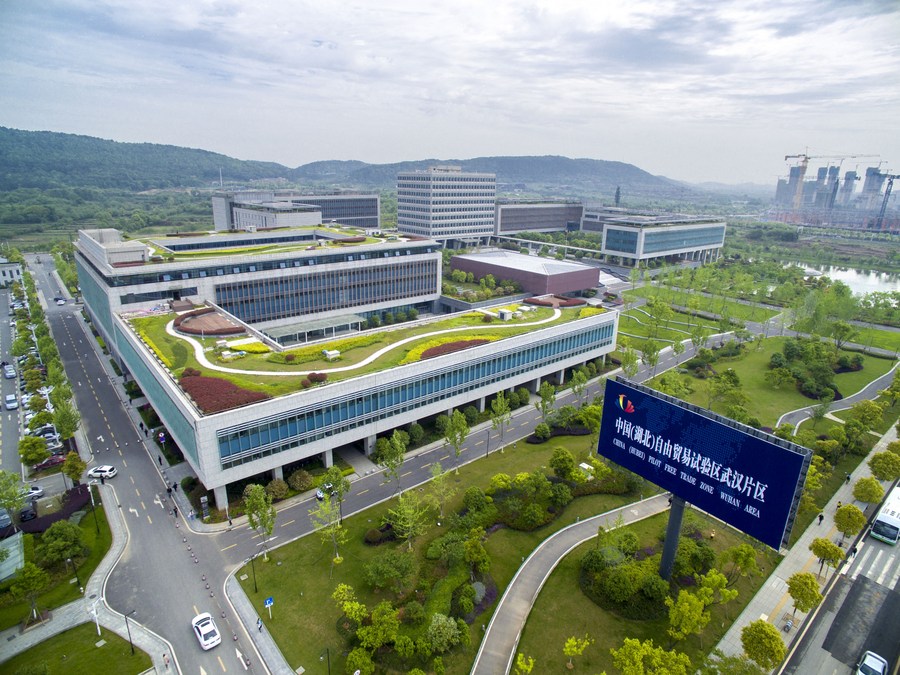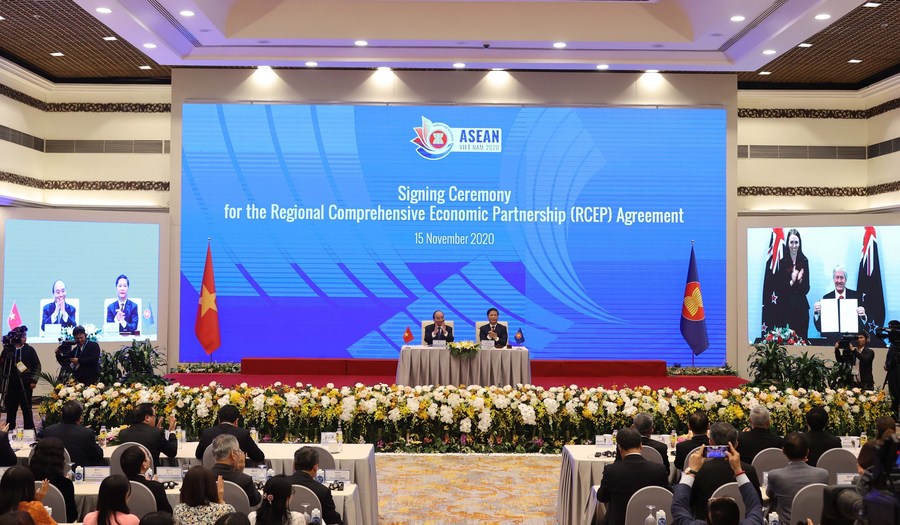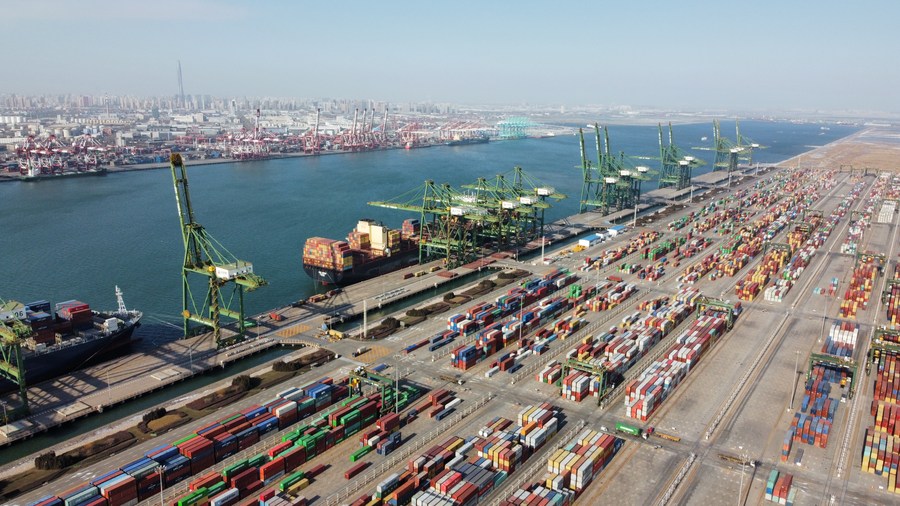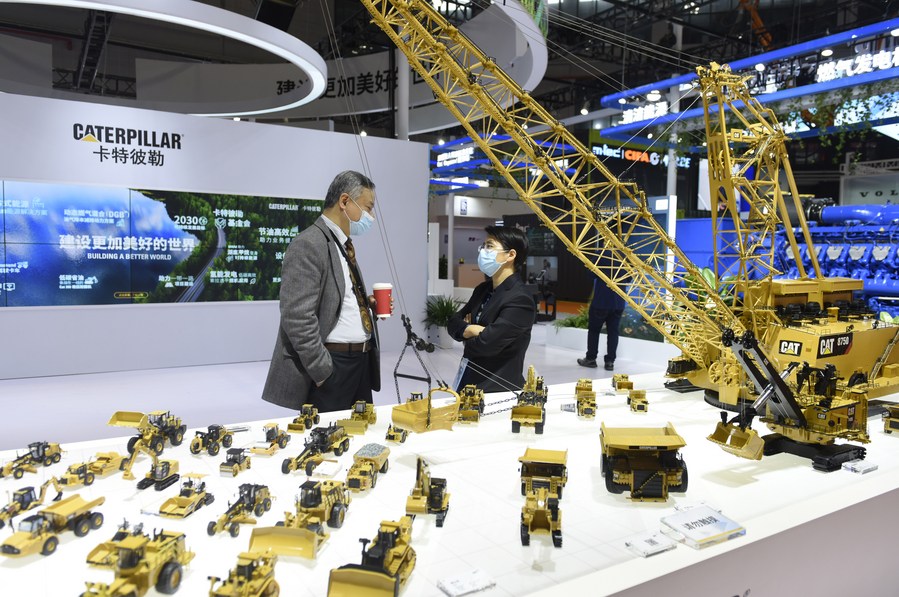China spearheads economic globalization two decades after WTO entry

Aerial photo taken on April 19, 2017 shows the pilot free trade zone (FTZ) in Wuhan, central China's Hubei Province. [Xinhua/Xiong Qi]
SHANGHAI -- China has emerged as a significant player, advancing economic globalization with openness as a hallmark and shared prosperity as a vision of the world's second-largest economy.
Since joining the World Trade Organization (WTO), the country's economic size has grown from the 6th to the second-largest in the world. Its trade in goods grew from the 6th to the first, and trade in services from the 11th to the second place worldwide.
It has led developing countries in utilized foreign investment, while outbound direct investment has risen from the 26th to the first position.
The changes mirrored China's consistent efforts in embracing the global economy by facilitating global trade and investment and upholding multilateralism.
DEEPER INTEGRATION
The latest moves to expand opening-up came at the fourth China International Import Expo (CIIE) that started on Thursday. At the expo, the country announced that it would set up more demonstration zones for the creative promotion of import trade. It will also promote Silk Road e-commerce.
China has previously designated several cities for developing international consumption centers, and it vowed at the CIIE that the building of such centers would accelerate. It would also establish a modern logistics system and boost its cross-border logistics capabilities to share the opening-up fruits with the world.
The opening-up determination has remained steadfast over time. Earlier in September, China announced new measures to open up its services sector. The measures include implementing a negative list for cross-border services trade and exploring the development of national demonstration zones for the innovative development of trade in services, among others.
Since 2013, China has built 21 pilot free trade zones, representing the new high ground for opening-up. Recent years have also seen opening-up measures, including enacting the foreign investment law, implementing pre-establishment national treatment, and shortening the negative list for foreign businesses.
The country has always supported multilateral and regional mechanisms to play a bigger role and developing countries to gain more representation.
Last month, China officially applied to join the Comprehensive and Progressive Agreement for Trans-Pacific Partnership and vowed more efforts to expand market access than its practices in any existing trade pact.
The Regional Comprehensive Economic Partnership (RCEP) agreement, which will take effect on Jan. 1, 2022, is the world's largest free trade agreement, covering about 30 percent of the world's population.
China, a member of the RCEP, has stated its readiness to further boost economic integration and recovery in the region through mutually beneficial cooperation with ASEAN on many occasions.

The signing ceremony of the Regional Comprehensive Economic Partnership (RCEP) agreement is held via video conference in Hanoi, Vietnam, Nov. 15, 2020. [VNA via Xinhua]
The enactment of the agreement is significant for further promoting intra-regional free trade, stabilizing industrial and supply chains, and promoting China's high-level opening-up, said China's Ministry of Commerce.
George Ye, vice president and general manager of Edwards Lifesciences Greater China, said China has made vital contributions to the world economy since its accession to the WTO.
The company is honored to witness China living up to its commitments when joining the WTO, continuing to open up to the outside world, accelerating the liberalization and facilitation of trade and investment, and improving its business environment, said Ye.
SHARED OPPORTUNITIES
As an old Chinese saying goes, "A single flower does not make spring." China's opening-up endeavors never lead to development behind closed doors, but mutual benefits enjoyed by all.
Over the years, China has unveiled multiple measures to lower market access thresholds to share market opportunities with the rest of the world.
It fulfilled its pledge of lowering the import tariff for goods to 9.8 percent from 15.3 percent when it joined the WTO 20 years ago. At present, its overall import tax stands at 7.4 percent, lower than the average level of developing members of the WTO, and is approaching the level of developed members of the organization.
Non-tariff barriers for international trade have also been significantly reduced, with non-tariff measures covering 424 tariff categories scrapped by January 2005.

Aerial photo taken on Jan. 11, 2021 shows a view of the Pacific international container terminal at Tianjin Port in north China's Tianjin Municipality. [Xinhua/Zhao Zishuo]
Just as China benefited from increased exports, its trading partners similarly benefited from China's increased purchasing power and rising imports, said Secretary-General of the United Nations Conference on Trade and Development Rebeca Grynspan.
The country has also endeavored to provide public goods to facilitate global and regional economic and social development.
The CIIE, the world's first import-themed national-level expo, is one of such platforms for international procurement, investment promotion, cultural exchanges, and open cooperation.
The ongoing fourth edition of the expo has drawn nearly 3,000 businesses from 127 countries and regions. Over 80 percent of the world's top 500 companies and industry leaders who participated in the previous expos are here this year. The total exhibition area for businesses has expanded to 366,000 square meters.
Enjoying a larger venue, a record number of U.S. companies are attending this year's event. It is also seeing the participation of 90 companies from 33 least developed countries.

Visitors talk with each other at the Caterpillar booth during the fourth China International Import Expo (CIIE) in Shanghai, east China, Nov. 5, 2021. [Xinhua/Xu Liang]
In the past 20 years, China has become the largest trading partner of most developing countries. Significantly, the country absorbs 20 percent of the least developed countries' exports, thanks to its duty-free and quota-free market-accessing initiative in favor of these countries, said Grynspan.
Eyeing more business opportunities from the world's largest market, participants from all over the world have hailed the CIIE as a platform for sharing China's development dividends.
Jose Vinals, chairman of Standard Chartered Group, said the expo is exciting and provides a powerful platform for exporters, suppliers, and service providers globally to connect with the opportunities in China.
When commenting on China's transformation in the past two decades, Fabrice Megarbane, President of L'Oreal North Asia Zone and Chief Executive Officer of L'Oreal China, said the country is committed to making the market more stable, transparent, predictable, and fair.
"It has also injected prosperity and stability into the whole world - from streamlining administration and delegating power, to reducing taxes and fees, international exchange to local innovation," said Megarbane.
The China-proposed Belt and Road Initiative (BRI), another global public good, has grown into the world's largest international cooperation platform over the past eight years, with over 200 cooperation agreements inked between China and over 170 countries and international organizations.
Through the BRI, China, in combination with different countries' competitive advantages, offered investments to accelerate economic development, and promote social welfare, said Sergei Glazyev, member of the board (minister) of the Eurasian Economic Commission.
China is leading the world's socio-economic development, and its proposal of building a community with a shared future for humanity inspires many Eurasian countries, Glazyev said.
WTO Director-General Ngozi Okonjo-Iweala said China has successfully positioned itself at the core of many global value chains. These production and trade networks have not only provided a lifeline for many countries during the pandemic, but also increased the quantity, quality, and variety of goods available worldwide.
Looking back over the past two decades, China's WTO accession is nothing less than the completion of the largest trading bridge between China and the West since Marco Polo's expedition in the 13th century, Okonjo-Iweala said.
"The WTO would not be the World Trade Organization without China," she said when addressing a high-level session held Friday on the 20th anniversary of China's accession to the WTO via video.
























